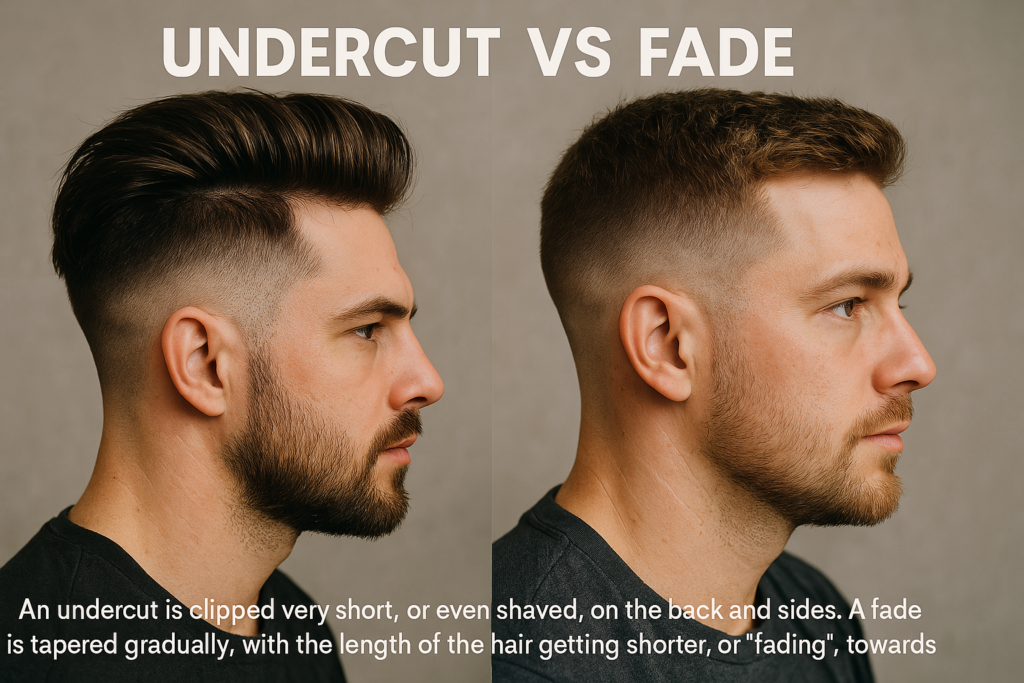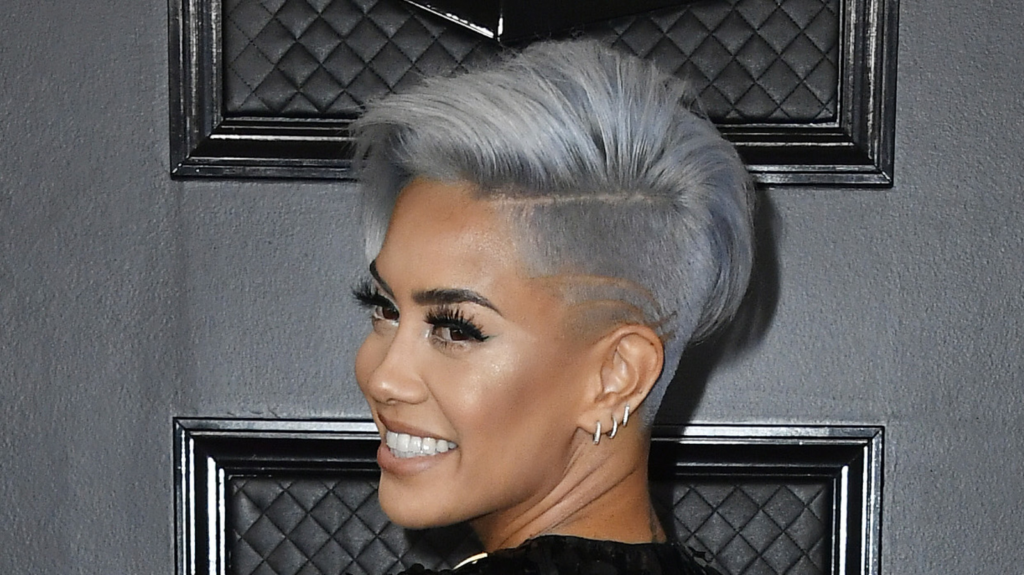If you’ve been thinking about switching up your look with a fresh new haircut, you’ve probably come across two major contenders: the fade and the undercut. Both are extremely popular and offer sleek, modern styles, but they each have distinct features that might make one a better choice for you than the other.
Let’s break down what each style really involves and how you can decide which is best for your hair type, lifestyle, and personal style.
At PlatinumCutz barbershop, we specialize in all types of modern men’s hairstyles — from clean fades to bold undercuts. If you’re not sure which style suits you best, here’s a quick guide to help you understand the difference.
FADE vs Undercut- Quick Difference
An undercut has a clear line between the long hair on top and short sides. A fade blends the hair slowly from short to long for a smoother, more natural look.

What Exactly is a Fade?

A fade is a haircut where the hair gradually shortens from the top down toward the sides and back. It’s one of those styles that’s subtle yet polished. Think of it like a smooth transition where the hair at the top stays longer, and the sides progressively get shorter until they either fade into the skin or a very short length. It’s all about that seamless blend and can be customized in different ways.
The beauty of a fade is its versatility. You can go for a low fade, which starts right around the ears and gives a softer, more subtle look. If you prefer something more noticeable, a high fade begins much higher up the sides of the head, creating a sharper contrast between the long hair on top and the short sides. And if you’re in the middle, there’s always the mid fade, which starts closer to the temples.
A fade haircut is typically neat, clean, and works well for just about any hair type, whether your hair is curly, straight, wavy, or even thick. This is why fades are such a go-to option. They give you the flexibility to keep things professional and sleek or add some texture and volume on top if you want a more relaxed look. It’s also a great option if you’re someone who doesn’t want to spend too much time styling your hair every day—just a quick trim every few weeks will keep you looking fresh. Read More About What is Fade.
What About the Undercut?

On the other hand, an undercut takes a bit more of a bold approach. With an undercut, the sides and back of your hair are shaved or clipped very short, while the hair on top remains longer. There’s no gradual blending like with a fade. Instead, there’s a sharp contrast between the short sides and the longer top. This creates that “disconnected” look, where the top and sides almost look like two different haircuts.
The undercut really stands out, and it’s a great choice for anyone looking for something a little more daring. The sharpness of the contrast makes it perfect for people who want their hairstyle to make a statement. Plus, the longer hair on top can be styled in so many ways—slicked back, messy, spiky, or even textured, depending on your mood or the occasion.
Because of the sharp difference in lengths, the undercut can be especially striking if you have thick hair. The longer hair on top adds volume, while the short sides keep things clean and tidy. If you have thinner hair, the undercut can still work, but you might need to do a bit more styling to give it some lift or texture to keep the volume up top.
So, Which One Should You Go For?
When deciding between a fade and an undercut, think about what kind of look you’re after and how much maintenance you’re comfortable with. If you want something more subtle and adaptable, the fade is a great choice.
It’s clean, sharp, and doesn’t require a lot of upkeep. Plus, it works with any face shape and pretty much any hair type. If you’re looking for a style that’s versatile, you can have a neat, professional look during the week and then add some texture or volume for a more casual look on the weekends.
On the other hand, if you want something more eye-catching, the undercut is your answer. It’s a statement haircut that demands attention. If you’re okay with the idea of frequent trips to the barber to maintain that contrast between the long top and short sides, the undercut will give you a bold look that really stands out. It’s definitely a great choice for anyone who loves experimenting with different hairstyles and doesn’t mind putting in a little extra effort to maintain it.
How to Style and Maintain Each Look
Both the fade and undercut require different styling techniques to ensure they look their best.
For a fade, the styling is generally much more straightforward. Since the fade tapers down from longer to shorter lengths, you don’t have to worry about making the sides and top look too separate.
You can keep things simple by either using a little styling product to give some texture or just keeping it clean. Depending on your hair type, a light pomade or wax can help define the top without making it look too stiff. If you want a more relaxed vibe, a bit of sea salt spray can give you that tousled, effortless look. The good news is, once your fade is styled, it’ll require very little day-to-day maintenance.
When it comes to the undercut, because of the sharp contrast between the top and sides, there’s often more emphasis on styling the longer hair on top. For that voluminous, sleek look, you’ll likely need a good strong-hold gel or pomade to keep the top in place. You could style it by combing it back, or you might choose to go with a more messy, textured style, depending on how you want it to look.
If you go for a slicked-back undercut, you’ll need a pomade with good hold and shine, but if you prefer a more natural, messy look, a matte wax or texturizing cream works best.
If you have curly hair, the undercut can give you the perfect opportunity to show off your curls in a more controlled yet bold way. Just make sure the hair on top has enough texture to keep the look dynamic, and don’t forget about regular trims to maintain the clean contrast between the long top and short sides.
The Role of Hair Length
The length of your hair plays a significant role in how both the fade and the undercut will look. A fade usually works well when your hair is cut to a medium length on top, and the sides get progressively shorter.
The length of the hair on top allows for a variety of styles, from a sleek, business-ready look to something more relaxed and tousled. If you have longer hair on top, a fade can still work, but you’ll need to keep the length on top manageable to maintain that clean transition. The great thing is that a fade can be as long or as short as you want, depending on the kind of style you’re aiming for.
For an undercut, the length of the hair on top can be as long as you like. However, because of the significant difference between the top and sides, it’s best to choose a length that complements your face shape and the look you’re going for. Some people love going for a dramatic undercut with super long hair on top, while others prefer something more moderate.
If you want a shorter undercut, the top can be around 2 to 4 inches, but for a longer look, you might grow it out to 6 inches or more. The length of the top really depends on personal preference and the kind of maintenance you’re prepared for.
Face Shape and Suitability
When choosing between a fade and an undercut, it’s essential to consider your face shape. Here’s how both styles can complement different face shapes:
- Fade:
- Oval faces: A fade looks great with oval-shaped faces because it enhances the natural symmetry. You can experiment with different fade lengths, and it’ll always balance out well.
- Round faces: If you have a round face, a fade—especially a high or mid fade—can create more angularity around the sides, making your face appear longer and more defined.
- Square faces: For square faces, a fade can help soften the strong jawlines while maintaining sharpness. A longer fade will help elongate the face and soften the angles.
- Heart-shaped faces: Fades work well for heart-shaped faces as the gradual tapering brings balance to the forehead while adding definition to the chin.
- Undercut:
- Oval faces: An undercut works well with an oval face because it adds dimension and draws attention to the top. It can help create volume without overwhelming the face shape.
- Round faces: The undercut can add height and make a round face appear more elongated. By keeping the top longer, it draws attention upwards, balancing out rounder features.
- Square faces: Square faces often suit the undercut, as it enhances strong jawlines and adds sharpness. It’s great for people who want to show off their face’s structure.
- Heart-shaped faces: An undercut can emphasize the chin and jaw area, balancing the forehead. The longer top can give the face a more even look overall.
How Long Does It Take to Grow Out?
If you’re someone who wants a style that’s easy to grow out and doesn’t require a lot of work once it’s started, a fade may be your best bet. The fade naturally blends as your hair grows, so it won’t leave you with awkward lengths or harsh lines once you hit the “in-between” phase. When it’s time for a trim, it’s just a quick refresh at the barber’s.
In contrast, an undercut requires a bit more effort if you decide to grow it out. Since the sides are so short compared to the top, it can leave you with a noticeable gap in length as your hair grows out. If you like having the clean, disconnected look, it’s a good idea to keep up with trims to avoid the “grow-out” stage, which can be tricky to manage. However, if you’re willing to embrace a longer hairstyle or you like transitioning your undercut into a new style, growing it out could lead to new possibilities like the pompadour or quiff.
Final Considerations: Cost of Maintenance
Both fade and undercut haircuts require regular maintenance, but the costs vary slightly depending on the amount of trimming and styling you need. Fades tend to be less expensive because they typically require fewer visits to the barber. You’ll probably need a fade touch-up about every 4 to 6 weeks, depending on how fast your hair grows.
Undercuts, because of their more dramatic contrast between the top and sides, might require a bit more frequent maintenance, and potentially more styling products. Depending on the style you choose (like longer tops or intricate designs on the sides), the costs might be a little higher, especially if you’re visiting a stylist who needs to carefully manage the transition from short to long hair.
